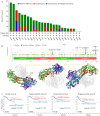A pan-cancer analysis of the role of hexokinase II (HK2) in human tumors
- PMID: 36335239
- PMCID: PMC9637150
- DOI: 10.1038/s41598-022-23598-8
A pan-cancer analysis of the role of hexokinase II (HK2) in human tumors
Abstract
More and more evidence show that HK2 is closely related to tumors. But no pan-cancer analysis is available. This paper aimed to explore the potential roles of HK2 across thirty-three tumors based on the datasets of the cancer genome Atlas (TCGA) and gene expression omnibus. HK2 is highly expressed in most tumors and related to the progression of some tumors. HK2 expression was associated with the infiltration of T follicular helper cells for the TCGA tumors of uveal melanoma, breast invasive carcinoma (BRCA), breast invasive carcinoma-luminalA (BRCA-LumA), head and neck squamous cell carcinoma (HNSC), head and neck squamous cell carcinoma with HPV positive (HNSC-HPV+), and cancer-associated fibroblasts for the tumors of brain lower grade glioma and stomach adenocarcinoma. Our first pan-cancer study offers a relatively comprehensive understanding of the roles of HK2 in different tumors.
© 2022. The Author(s).
Conflict of interest statement
The authors declare no competing interests.
Figures





Similar articles
-
FDCSP Is an Immune-Associated Prognostic Biomarker in HPV-Positive Head and Neck Squamous Carcinoma.Biomolecules. 2022 Oct 12;12(10):1458. doi: 10.3390/biom12101458. Biomolecules. 2022. PMID: 36291667 Free PMC article.
-
Hexokinase 2 overexpression promotes the proliferation and survival of laryngeal squamous cell carcinoma.Tumour Biol. 2014 Apr;35(4):3743-53. doi: 10.1007/s13277-013-1496-2. Epub 2013 Dec 21. Tumour Biol. 2014. PMID: 24363061
-
A pan-cancer analysis of the role of argininosuccinate synthase 1 in human tumors.Front Oncol. 2023 Nov 20;13:1049147. doi: 10.3389/fonc.2023.1049147. eCollection 2023. Front Oncol. 2023. PMID: 38053661 Free PMC article.
-
The interplay between HPV and host immunity in head and neck squamous cell carcinoma.Int J Cancer. 2014 Jun 15;134(12):2755-63. doi: 10.1002/ijc.28411. Epub 2013 Aug 29. Int J Cancer. 2014. PMID: 23913554 Review.
-
The cancer driver genes IDH1/2, JARID1C/ KDM5C, and UTX/ KDM6A: crosstalk between histone demethylation and hypoxic reprogramming in cancer metabolism.Exp Mol Med. 2019 Jun 20;51(6):1-17. doi: 10.1038/s12276-019-0230-6. Exp Mol Med. 2019. PMID: 31221981 Free PMC article. Review.
Cited by
-
The role of immune metabolism in skin cancers: implications for pathogenesis and therapy.Transl Cancer Res. 2024 Jul 31;13(7):3898-3903. doi: 10.21037/tcr-24-695. Epub 2024 Jul 26. Transl Cancer Res. 2024. PMID: 39145080 Free PMC article. Review.
-
The Antitumor Role of Incomptine A in a Breast Cancer Murine Model: Impairment of Hexokinase II Expression and Apoptosis Induction.Cells. 2025 Aug 2;14(15):1192. doi: 10.3390/cells14151192. Cells. 2025. PMID: 40801624 Free PMC article.
-
Disruption of proteome by an oncogenic fusion kinase alters metabolism in fibrolamellar hepatocellular carcinoma.Sci Adv. 2023 Jun 23;9(25):eadg7038. doi: 10.1126/sciadv.adg7038. Epub 2023 Jun 21. Sci Adv. 2023. PMID: 37343102 Free PMC article.
-
A CRISPR-edited isoform of the AMPK kinase LKB1 improves the response to cisplatin in A549 lung cancer cells.J Biol Chem. 2025 Mar;301(3):108308. doi: 10.1016/j.jbc.2025.108308. Epub 2025 Feb 13. J Biol Chem. 2025. PMID: 39955067 Free PMC article.
-
An in- vitro measurement for the toxicity of peptides inhibit hexokinase II in breast cancer cell lines.Sci Rep. 2025 Mar 27;15(1):10660. doi: 10.1038/s41598-025-94858-6. Sci Rep. 2025. PMID: 40148397 Free PMC article.
References
Publication types
MeSH terms
Substances
Grants and funding
LinkOut - more resources
Full Text Sources
Medical

